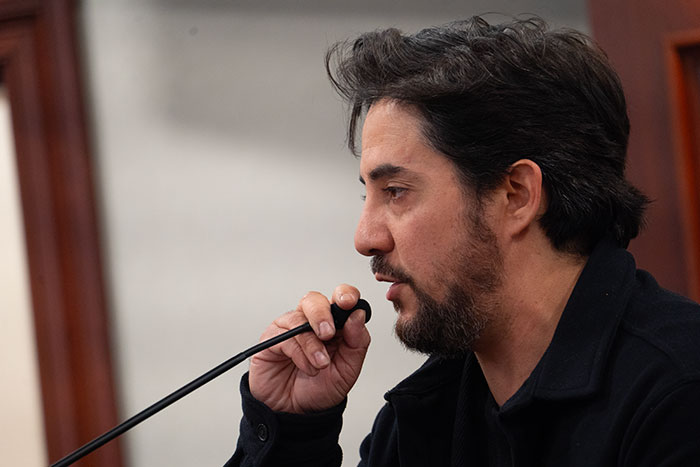Pomona College student, Heritage combine with online blog

Pomona College senior and Claremont Heritage archival intern Cooper Crane is the author of Heritage’s historic blog, “History of Claremont in 100 Objects.” Courier photo/Andrew Alonzo
by Andrew Alonzo | aalonzo@claremont-courier.com
Cooper Crane, a 26-year-old Pomona College senior, is bringing to life an ambition he’s had for the last few years.
Building on a podcast called “The History of the World in 100 Objects,” a joint project by the British Broadcasting Corporation and British Museum that looks at world history through various objects, Crane is aiming to deliver that same type of historical spotlight locally.
Combining his passions for archeology and history, Crane began a blog with the help of Claremont Heritage called “A History of Claremont in 100 Objects,” an exploration of California’s extensive history using objects and archives mostly found at the Garner House. The blog can be viewed at claremont-heritage.blogspot.com.

A citrus packing label from the Goleta Lemon Association will eventually find its way into the Claremont Heritage blog, “History of Claremont in 100 Objects.” Courier photo/Andrew Alonzo
As a student at Norco College, Cooper was introduced to the BBC podcast and latched on to the idea.
“It was a really interesting podcast because I had never been exposed to something that uses things as a vehicle to sort of discuss history,” he said. “I mean it seems obvious but things have a history all on their own and very frequently they can actually say things that sometimes written words can’t.”
When he enrolled at Pomona College a short time later and became acquainted with Claremont Heritage, he found a way to make the project a reality. For the past year, Crane has worked as an archival intern at Claremont Heritage, and personally enjoys being able to uphold history with the local nonprofit history keepers.
Since December 2023, Crane has been posting objects for the blog. The first post was about a heliotherapy lamp known as a radiant therapy machine that was built by the Paul E. Johnson Company and taken from the Mary Garner Hirsch Collection. Hirsch was the granddaughter of Herman and Bess Garner who built the Garner House.
Other posts came in the months that followed and included a pair of black stereoscopic goggles called a Viewmaster, unveiled at the New York World’s Fair in 1939, which was donated to the Foster Rhodes Jackson Collection at Claremont Heritage; the Garner House’s 1947 Philco Model 50-T1478 television and radio set; a four-foot-long, two-foot-wide Balsa wood surfboard at the Garner House that was likely used by the sons of Herman and Bess Garner; and an orchard heater, or smudge pot, which was used to prevent citrus plants from frosting over during winter. Aside from the Viewmaster, the other objects were part of the Mary Garner Hirsch Collection.
“It’s kind of a multifaceted approach to history,” Crane said. “I think that it’s a really good vehicle to talk about history because people like looking at interesting objects. That’s one of the reasons we go to museums.”
Crane said another reason museums put objects on display is because they have a story to tell.
With each blog post, Crane is hoping to deliver an interesting story to the viewer, while also explaining why we need to think critically and carefully about what a certain object says or relates to.
“When people read the blog, I want them to be able to see the connections that I’m making between some of these objects, like the social and cultural relationships that are embedded within them,” he said.
Though objects have yet to be entered, including a Kohler combination sink and dishwasher from the early 1900s; a vintage Vulcan-branded insulated stove; childhood games, a bicycle and football gear taken from the children’s rooms at the Garner House; and citrus packing labels from the Goleta Lemon Association and other brands, Crane hopes to continue making entries to the database with the goal of hitting the 100-object mark.
The ambitious Pomona College student admits that while he does not have 100 objects picked out for the blog, one of the ways he plans to reach that milestone is to start filtering artworks and architectural pieces that were created by household Claremont names. While some of the objects won’t specifically talk about the history of the City of Trees, Crane believes the completed blog will do justice to the history of Claremont.
Part of the challenge in pulling off this project, he says, has been his ability to share a cohesive, historical narrative that is both encompassing and concise.
“The most difficult part for me is like, it’s the expression ‘kill your darlings,’” he said, which means self-editing. “There are some parts of a blog that are really interesting that you just have to decide, you have to cut out because … it doesn’t fit as well as other parts and it doesn’t really contribute to the blog as much as much as you thought it did in the moment.”
He also said finding credible sources of information can sometimes be challenging.
Through the blog, Crane is hoping to inspire the public to develop a greater appreciation for history as well as the objects surrounding us.
“I want to be able to write more blog posts in which people can read that and take away from that and … critically assess and analyze the different ways that objects show how the world basically came to be shaped in the way that it is today,” he said.
While his time at Claremont Heritage is set to end after his May 12 graduation from Pomona College, Crane plans to keep the blog going with remote updates every two weeks.
It’s an ambitious promise he’ll try to keep as he begins to fill out graduate school applications.










0 Comments